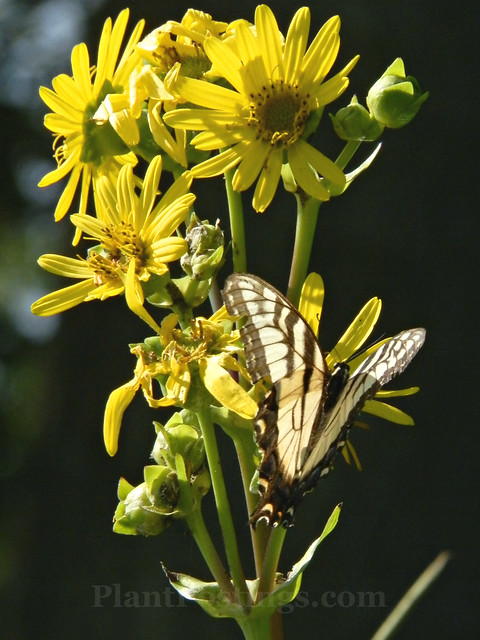
What a difference a week makes! In my last post, we still hadn't had a killing frost. Then this past Friday, Nov. 20, we had a snowstorm that brought us about five inches of fresh white stuff.
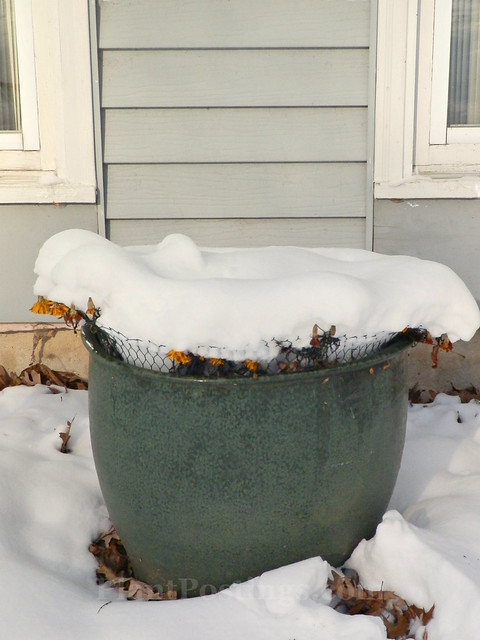
The Marigolds are history now. It's weird to have a late frost and an early snow in the same season. But it is what it is.
So ... no more outdoor blooming plants around here until spring. There will be several months ahead to talk about winter, so I'm stepping back in time. My plant of the month for November is one that blooms in mid- to late summer.

The Cup Plant (Silphium perfoliatum) has a pretty, yellow Daisy-like flower. It's not a huge flower (about 3" in diameter).
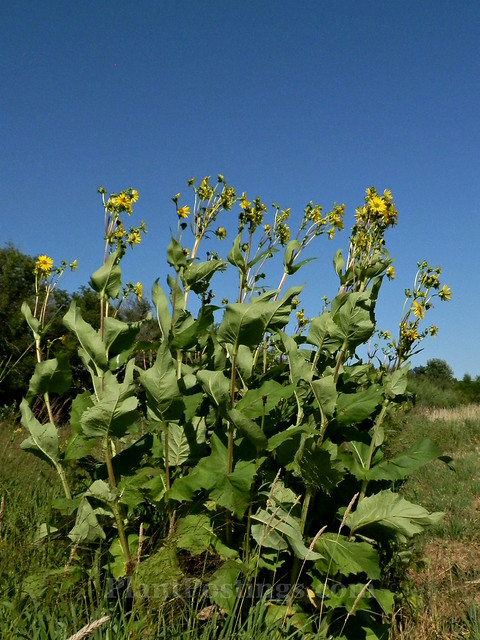
But the plant itself is very large and tall (4 ft. to 10 ft.), towering over other plants in its native prairie habitat: from Ontario south to Georgia and west to the Dakotas and Oklahoma. Cup Plant is hardy in USDA zones 3 to 9.
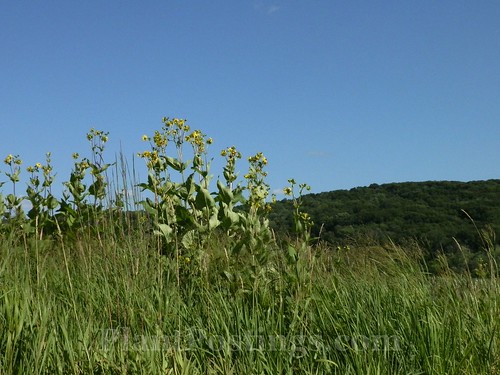
In fact, like the other Silphiums, including Prairie Dock (S. terebinthinaceum) and Compass Plant (S. laciniatum), Cup Plant even towers over the tall prairie grasses. Wholeleaf Rosinweed (S. integrifolium) is a bit shorter, at 2 ft. to 6 ft.
I've never tried this, but I'm thinking Cup Plant would work well along a tall wall, at the back of a garden bed. Cup Plant thrives in normal to wet garden soils, and will tolerate clay soil, according to the Lady Bird Johnson Wildflower Center. Once established, however, it has a high tolerance for drought, due to its long tap root, which can extend 12 ft. to 14 ft deep.
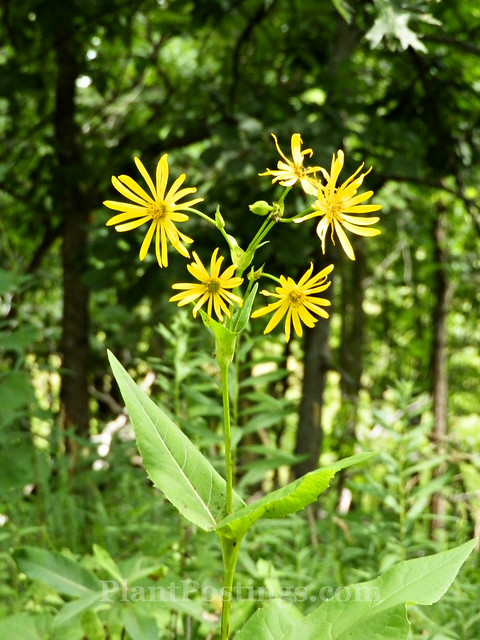
Being a prairie plant, it prefers full sun. But I've also often seen it growing at the edges of woodlands, in partial sun. This is one of the fishman's favorite plants. We frequently see Cup Plants along our hiking trails.
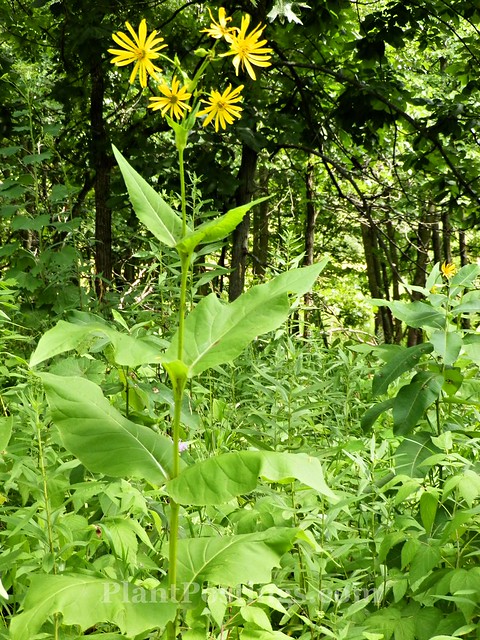
The fishman gets a kick out of the structure of the leaves, where they come together at the stem.
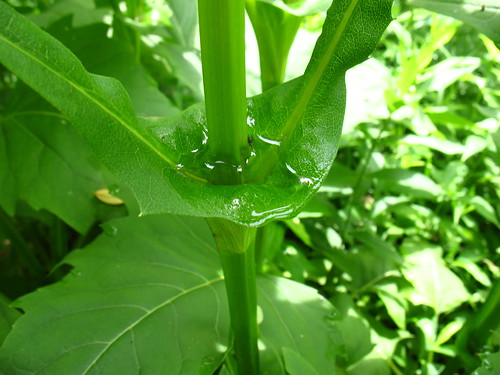 |
Photo by Vilseskogen via Creative Commons
|
They form cups that collect rain water, which attracts birds and pollinators.
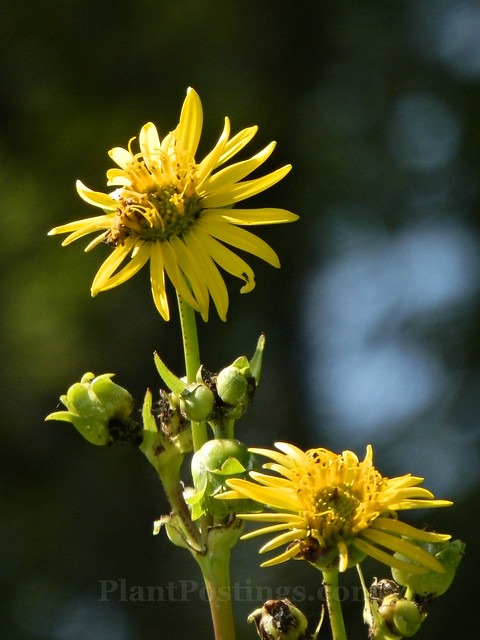
Cup Plant provides special value to native bees and honey bees, and provides nesting materials/structure for native bees, according to the Xerces Society for Invertebrate Conservation.
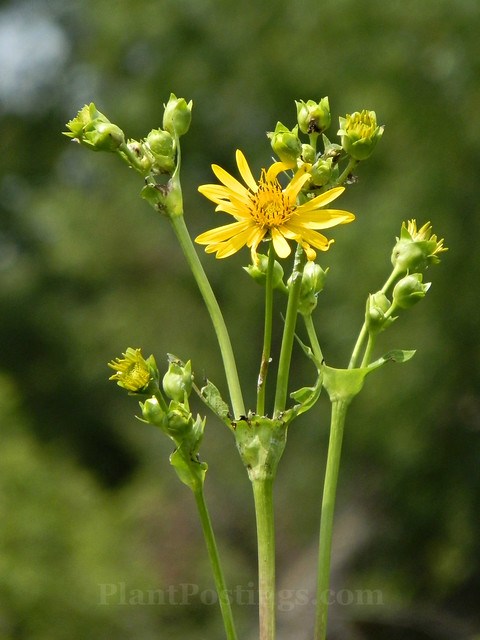
It has an "unstoppable urge to reproduce," describes The Lady Bird Johnson Wildflower Center. "They will pop up everywhere; very little care needed."
I know butterflies are attracted to Cup Plant--during one hike this past summer, we noticed Tiger Swallowtails all over it.
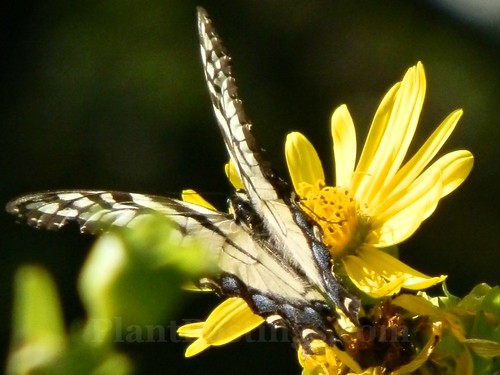
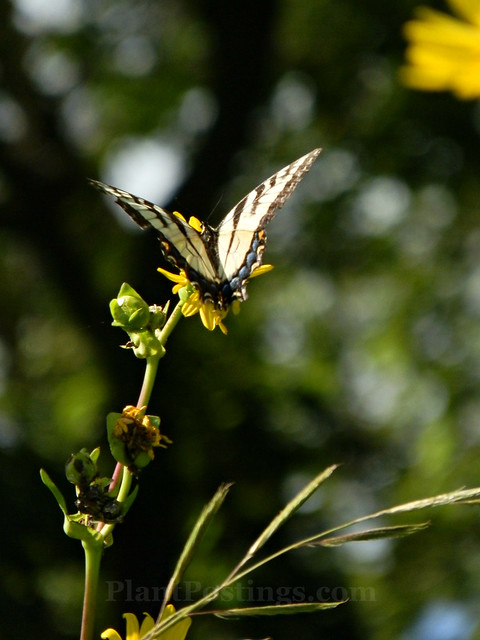
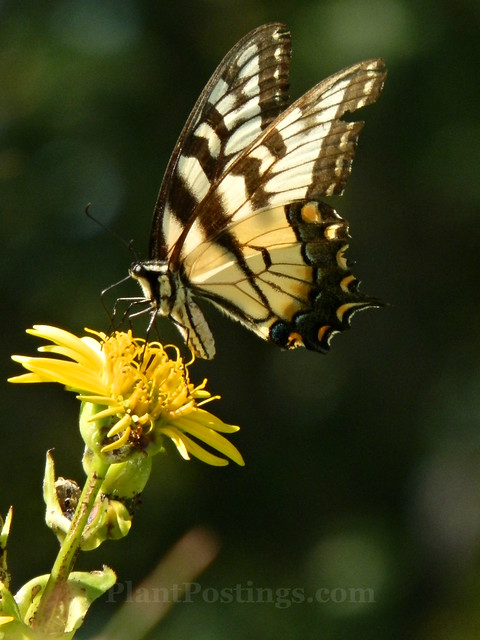
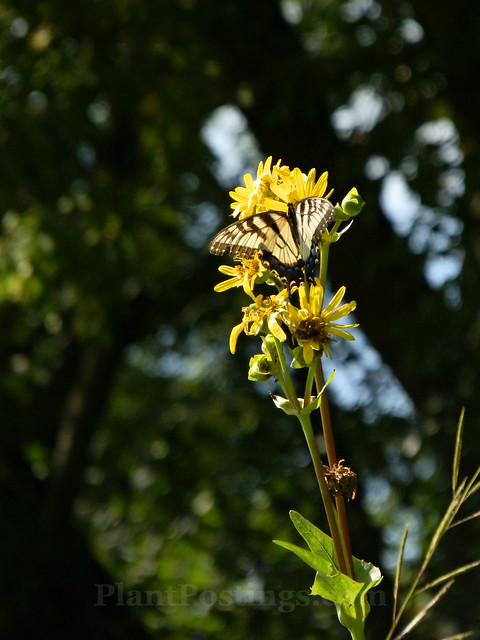
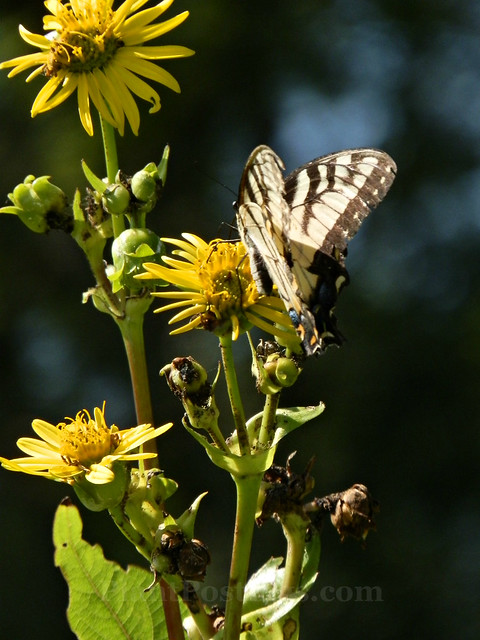


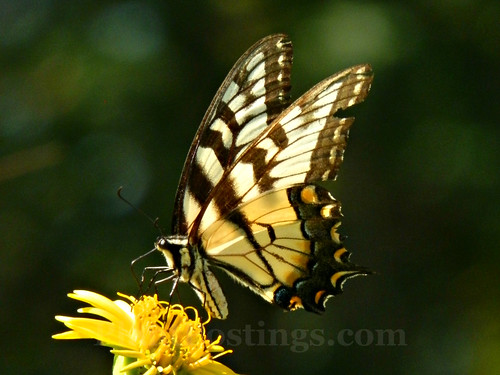
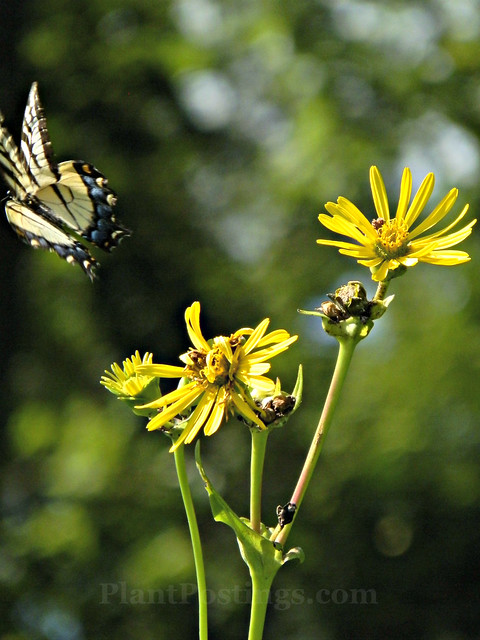
Bye-bye!
I'm linking this post to Gail's Wildflower Wednesday meme at Clay and Limestone and Diana's Dozens for Diana at Elephant's Eye on False Bay. Head on over to their blogs to learn more about wildflowers and unique plants from around the world.
Next up: the quarterly Garden Lessons Learned meme! What have you learned in your garden during the past few months? Donna at Gardens Eye View also hosts her companion Seasonal Celebrations meme. I hope you'll join us. You can share posts for both memes, or one post that covers both lessons and celebrations.
Happy Thanksgiving! Season's Greetings!
thanks for a fascinating and unique plant. I admired that when I first saw it at Clay and Limestone. That cup of water seems like a good idea that other plants could copy.
ReplyDeleteHi Diana: Yes, it's a fun plant. Not one I'd ever thought to plant myself until recently, although it's great fun to encounter during a hike or a prairie walk. The cupping of the leaves along the stems makes it a special wildflower, indeed.
DeleteWow, that's a lot of snow already! It seems too soon, with the beautiful November weather we've had! I've always found the Cup Plant to be so fascinating with the little cup of water it provides for the wildlife. I haven't really seen them planted in gardens much, though, so that would be interesting to see how they look in that setting.
ReplyDeleteHa! Yes, it was an unexpected, early snow. But it all melted before Thanksgiving, and now we have green grass and evergreen foliage everywhere. If you didn't know the season, you might say it looks like early spring. We had amazing weather up until the snow, and now we're back to "normal" or slightly warmer than average weather. I haven't seen the Cup Plants much in gardens, either. My current garden probably isn't the best place for it, but maybe someday...
DeleteLove the drama of this plant. And your photos are so lovely - and informative. Happy thanksgiving!
ReplyDeleteThanks, Linda! I really enjoy finding this plant, along with the other Silphiums, along our hikes during the mid- to late summer. They tower over everything else, and definitely attract wildlife and pollinators. Thanksgiving was busy but wonderful--hope yours was, too!
DeleteAt the first sight, I think that's a kind of sunflower. That's a new plant for me. thanks for sharing
ReplyDeleteThey do resemble tall Sunflowers, and both Sunflowers (Helianthus) and the Silphiums are in the Asteraceae family. The Silphiums don't seem to be common garden plants, which is too bad because they provide plentiful wildlife value, they're interesting, and they're beautiful.
DeleteIt was one of the last blooming plants in my garden this year. I did regret the height of the plant though for such a small garden. I doubt it will stay in my garden even though it has been there for a few years. Just too big.
ReplyDeleteYeah, I'm not sure it's right for my current garden either. But it could work well in the right place--maybe a large sunny garden that needs a tall, robust plant as a background anchor.
DeleteI have so much trouble identifying the different tall yellow native flowers, but this is one I can usually recognize, thanks to the "cups" formed by the leaves. It's one I've been wanting to add here for awhile. I have the perfect place for it--alongside an old shed, where I've already planted some milkweed seeds for next year. Now, if I can just keep Mr. P from spraying weedkiller there next year! Long story, but I was not a happy gardener last spring:(
ReplyDeleteYes, it sounds perfect for that spot, Rose! I remember you describing that location, along with the disappearing Milkweed. Good luck! I hope you'll have many native wildflowers growing successfully there next season!
DeleteA really gorgeous wildflower and your photos do the plant justice! You and I both chose native sunflower-type perennials to profile and with similar growth and blooming habits. Yellow flowers--can a garden do without them?
ReplyDeleteThanks, Tina. Yes, it is a beauty, and very utilitarian and a native plant, as well! I agree--can a garden do without these types of tall accent plants with golden blooms?!
DeleteYes, I reckon it could look pretty good at the back of the border. You make it even more interesting with those great shots of the butterflies.
ReplyDeleteThanks, Alistair. During this particular hike, the Monarchs were all over the Goldenrods and the Joe Pye, while the Swallowtails seemed to prefer the Cup Plants.
DeleteGreat profile of what looks like a wonderful native plant. Chanticleer's cutting garden was totally filled with very tall plants this year and looked spectacular. The gardeners in charge said she wanted to create an Alice in wonderland feeling for visitors, and she did. I took a lot of photos and may do a post. I will have to see if I recognize cup plant in the photos.
ReplyDeleteHi Carolyn: Oh, I hope you will do a post about Chanticleer's unique look this year. That would be fun to read and see! Yes, Cup Plant and the other Silphiums are pretty special. I really enjoy seeing them rising out of the prairie during the summertime.
DeleteSo interesting, especially the root length--wow!
ReplyDeleteYes, the prairie plants, in general, have very deep roots. The soil is so good, and the plants take advantage of it. Unfortunately, because of this wonderful soil, much of it is gone. Of course we need to feed people, but it's sad to think of how common prairies once were, and how rare true remnants are because of agriculture and development.
DeleteYour photographs are really stunning Beth! You should send some in to National Geo. although I'm sure the competition is steep...what a charming wildflower with a heartwarming cup to offer its pollinators.
ReplyDeleteThank you, Susie. You're too kind. Yes, the Cup Plant is a great one--for so many reasons!
DeleteWhat gorgeous photos with the butterfly! I have cup plants in my garden & only this year found out that's what they were - in fact, it was at the Fling when we saw them in a garden and I asked someone (I think it may have been Tammy). You are so right - It's a real trouper and definitely drought tolerant when established as I never water that area (not even during that summer drought a couple of years ago) and have never had an issue. Little by little, I'll eventually identify all of the plants in my garden ;)
ReplyDeleteI hope that you and your famiy have a wonderful Thanksgiving!
Thanks, Margaret. I hope you had a great Thanksgiving, too! How fun that you actually have Cup Plants in your garden! The birds, bees, butterflies, and wildlife must really love it!
DeleteNow you're talking! This is one of my favorite plants. Along with bees and butterflies, it's also a favorite for goldfinches. As you know, I have it in my garden, but I don't find it too difficult to keep under control. Great photos, by the way.
ReplyDeleteGood to know about your experiences with it, too, Jason. Ah, I can imagine it being very popular with the Goldfinches. Thanks for your kind words.
DeleteI've never grown a cup plant even though I have the room. I guess it's something I will have to take a look at in the future. We haven't had snow 'yet', it's been raining all day but the snow line was northwest of here. I'm holding out hope that we'll miss this one even though I know it's only a matter of time. I hope you had a wonderful Thanksgiving!
ReplyDeleteStrange weather patterns this year. Late frost, early snow. And now it's all melted and we're getting milder weather again. Re: The Cup Plant--I hope to add it and/or one of the other Silphiums to a garden at some point in the future, too. We had a nice Thanksgiving. I hope you did, too!
DeleteQuite a dramatical plant, I have never grown it, but I found out that seeds can be bought here. It´s wonderful with the wonderful butterflies.
ReplyDeleteYes, it is dramatic, and very fun to find along a hike. And most likely, if you find this plant, you will find butterflies!
DeleteBeautiful photos of such a happy, pretty little flower. And your shots of the swallowtail are stunning. Thanks for the step back to late fall :) I know- we got 9 inches of the white stuff last week!
ReplyDeleteThanks, Diane. Is your snow melted now? Ours melted with the heavy rains on Wednesday and Thursday. And now the weather is turning mildish again. Hope you had a great Thanksgiving!
DeleteMy word, that's a long tap root. I really like the thick square stems (and, of course, the lovely flower). Great photos - I especially liked the ones with the butterfly.
ReplyDeleteI'm hoping we don't get that much snow all winter - never mind in one storm. Hope you're doing ok!
Thanks, Tim. Yes, the taproots of these prairie plants are incredible. And most of the prairie plants are visually beautiful, too. The snow has melted, but I'm sure we'll get more in the weeks ahead. Our normal season-long snowfall is about 50 inches.
DeleteThis sounds like a fabulous plant for a wildflower meadow, not only for its lovely yellow blooms that would be so pretty en masse, but also because the butterflies and bees obviously love it. The tap root sounds fearsome!
ReplyDeleteYes, it is a great meadow/prairie plant. Or even in an average-size suburban garden that has a sunny swathe of land. The taproots of the Silphiums and other prairie plants are impressive!
DeleteThis is on my list to plant....
ReplyDeleteOh, I'll look forward to learning about how it performs in your garden! Cheers!
DeleteI adore Cup Plant and have it in my meadow....since the deer left it alone this year it grew and flowered. You had more snow than we did...just a dusting here...very strange November.
ReplyDeleteThe Cup Plant must look stunning in your meadow, Donna! Do the deer sometimes eat it? Yes, we had one five-inch storm. It melted before Thanksgiving, and now we're back to "mild" weather. Yes, we had the second warmest November on record, even though we had an early snow.
DeleteI have a fondness for tall perennials, just wish I had room for more of them.
ReplyDeleteI do, too, Les. And I wish I had more sun. Next garden! I have sunny, roomy gardens planned in my head...
Delete